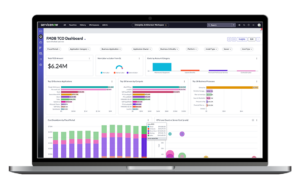As organizations increasingly rely on technology to drive growth and transformation, it’s critical that IT and business leaders work together to maximize the value of tech spend and ensure it stays closely aligned with enterprise objectives. But in the absence of clearly defined allocation and consumption metrics, business leaders often can’t understand their IT costs or what they’re receiving in return for those costs – causing needless frustration, mistrust, misguided consumption, and wasted resources.
A showback or chargeback model remedies this problem by joining the threads of IT spend, customer consumption, and business capabilities – enabling a more intelligent conversation around how technology resources are distributed and the value they provide.
That said, let’s take a deeper look at the anatomy of a showback or chargeback, how they both work, and what makes them different.
The Tactical Difference Between Showback and Chargeback
Showbacks and chargebacks are more alike than they are different. From a mathematics and content perspective, they share the exact same structure.
The only tactical difference between showback and chargeback is what they deliver to consumers in your bill of IT – either a report “showing back” costs and consumption, or the same information delivered as an invoice for payment:
- In a showback model, there are no bills or invoices paid by consumers. IT reports out costs and usage, while also maintaining ownership of budget funds – meaning no cost recovery is needed and no money ever changes hands within the organization. Since IT is a cost center, costs still must be allocated to business units, but these allocations are often disconnected from a showback.
- In a chargeback model, departments or agencies own and manage their own budget funds. IT buys the resources to deliver services, but each consumer department must then submit internal payment back to IT based on usage. This payment can take the form of actual cash changing hands (common in the case of public entities) or in the form of a journal entry charging the consuming department for their resource usage. Then, there may be a true-up to manage the over/under between the amount of expense truly incurred and the costs associated with what is charged to consumers. In other words, a chargeback is essentially a showback with more teeth.
The Strategic Difference Between Chargebacks and Showbacks
Despite the similarity between showback and chargeback on a tactical level, they’re quite different in terms of capabilities related to cost allocation and cost management.
From a strategic perspective, the key differentiator is the degree to which they enable you to drive accountability and optimize resource usage behavior.
Since a showback doesn’t invoice consumers and collect payment, it lacks an enforcement mechanism to encourage consumers to pay attention to their resource consumption and be proactive. Unless your consumers are exceptionally thoughtful and conscientious – even when there’s no financial incentive – then a chargeback is likely the only way you’ll be able to stimulate positive change.
As a result, most organizations use showback as a stepping-stone to chargeback. And it’s a smart approach: testing the bill of IT as a showback to work out any kinks, giving consumers time to raise questions and get familiar with the process, and then moving to a chargeback once everything is running smoothly.
Keep in mind though, showback is still a powerful tool for giving business leaders better visibility into costs and consumption, demonstrating the value of IT, and exposing levers to optimize spend. And it’s not uncommon for organizations to delay, or entirely forego, moving to a chargeback after starting with showback and finding it sufficient.
Pros and Cons: Showback vs. Chargeback
Now that you know the differences between showback and chargeback and what each model can help you accomplish, here’s a simple list of pros and cons to recap what we’ve discussed – and to note a few other important points you should consider.
Showback pros:
- Exposes levers for consumers to impact costs and optimize usage.
- Establishes a firm connection between IT spend and business capabilities (demonstrates value).
- Enables fair cost comparisons against outside suppliers.
- Implements more rapidly than chargeback.
- Requires no changes to existing financial systems.
- Results in no under/over, and thus requires no true-up.
- Carries a lower consequence of error.
- Offers the chance to refine cost distributions and allocations (especially useful if planning to move toward a chargeback).
Showback cons:
- Gives the visibility to spot problematic spend, but no mechanism to enforce accountability and fix it.
- Offers no functionality to collect payment and recover costs.
- Requires more education and socialization to solicit action from consumers.
Chargeback pros:
- Captures all the benefits of a showback-only model.
- Promotes total accountability by financially incentivizing consumers.
- Helps guide adoption or discontinuation of services through strategic pricing.
- Allows IT to collect payment and recover costs across multiple departments or agencies.
Chargeback cons:
- Brings higher risk of conflict regarding equitability of cost distribution and allocations.
- Requires a monthly or yearly true-up.
- Carries a higher consequence of error.
- Requires all the same setup work as a showback, plus new process creation and integration with existing financial systems.
- Presents a higher risk of failure and abandonment without thorough preparation prior to launch and strong support from leadership.
Just to reiterate, a chargeback is simply a showback plus invoicing. That means a chargeback can drive all the same outcomes as a showback, but it adds the ability to enforce accountability with real invoices and guide usage behavior through strategic pricing.
What’s the Best Way to Get Started?
For organizations with no prior experience generating a bill of IT, a simple showback is the best first step – primarily because it requires minimal setup effort (no new processes or accounting stream integration), and there’s minimal risk if something goes wrong.
Even if you have requirements that dictate chargeback as your ultimate long-term goal, starting with a showback gives you the chance to refine the model and socialize it across the business. That way, everyone will be fully prepared if/when you move to a full chargeback.
For anyone seeking more guidance on the showback or chargeback journey, we’ve created a comprehensive eBook that details every step of the process: “How to Produce an Effective Bill of IT Using Showback or Chargeback.”
Inside, you’ll get a detailed, step-by-step look at how to build a new showback or chargeback process from the ground up — as well as some strategic tips for long-term success.





